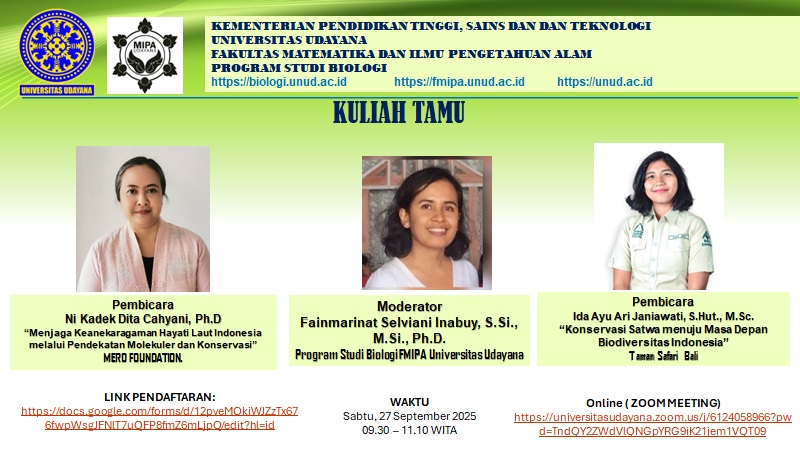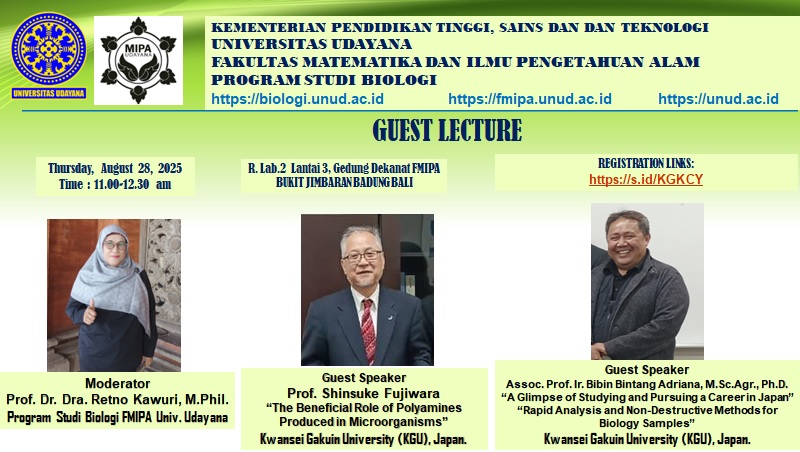Exchange information while initiate collaboration on The 1st International Symposium on “Climate Change Adaptation and Mitigation with Blue Carbon: Cross-sectional Research from Two Islands”
Two
forestry research organizations, CIFOR (Center for International Forestry
Research) and NiFoS (National Institute of Forest Science) organized a
symposium on climate change adaptation and mitigation through blue carbon
entitled The 1st International Symposium on "Climate Change Adaptation
and Mitigation with Blue Carbon: Cross-sectional Research from Two
Islands" on March, 27th – 28th. This symposium
collaborates with various parties, such as Udayana University (from the Faculty
of Mathematics and Natural Sciences and the Faculty of Marine and Fisheries)
and BRIN (National Research and Innovation Agency), as well as support from the
Bali BKSDA, UPT Ngurah Rai Forest Park, and Dhyana Pura University.
This
symposium aims to exchange information on research related to mangroves,
especially the ability to immersion carbon in mangroves. Mangroves are plant
communities that live in intertidal areas and have a high carbon immersion
ability, so they have the potential to mitigate climate change.
The
symposium activity began with remarks from CIFOR by Himlal Baral, followed by
remarks from the dean of FMIPA Unud by Ni Luh Watiniasih, as well as remarks
and opening remarks by BKSDA represented by Lanang Aryawan and remarks from
NiFoS by Sang-hyun Lee. After the event was officially opened, it was continued
with plenary 1 with several topics, including: (1) Overview of mangrove research
in Bali by Mr. Ketut Subandi from Tahura Ngurah Rai, (2) Overview of mangrove
research in Indonesia by Prof. Budi Leksono from BRIN, (3) Mangrove research on
biodiversity and carbon stock in Bali by I Made Saka Wijaya from Biology Study
Program FMIPA Udayana University, (4)
Mangrove research on bioactive compounds by Putu Angga Wiradana from Dhyana
Pura University, (5) Future research and prospect on mangroves by Mihyun Seol
from NiFOS, (6) Introduction, scope, and perspectives in mangrove research by
Bora Lee from NiFOS, (7) Indonesian mangrove restoration opportunities by Sigit
Sasmito from CIFOR, (8) Understanding field surveys and protocols by Chanwoo
Park from NiFOS, (9) Mapping and site
selection in mangrove research by Agus M. Maulana from CIFOR, and (10) Data
analysis and findings by Citra Gilang from the University of Muhammadiyah
Malang.
The event lasted for two days. After the workshop and seminar on the first day with 10 topics, the activity continued with observation and use of tools in the field. This field activity is not only aimed at data collection practices, but also the introduction of true mangrove species in Bali, especially in Tahura Ngurah Rai. When compared to Jeju Island in South Korea which is the site of research from NiFOS, the existence of true mangroves in Bali is much more numerous and diverse, so this provides new information for the team from NiFOS. The same thing was also obtained by the team from Bali, especially in the use of very modern research tools, such as carbon dioxide conductance counters, photosynthesis rate, and soil respiration rate. With this activity, it is hoped that all parties will be able to obtain new information about mangrove research.


.jpg)
FACULTY OF MATHEMATIC AND NATURAL SCIENCES